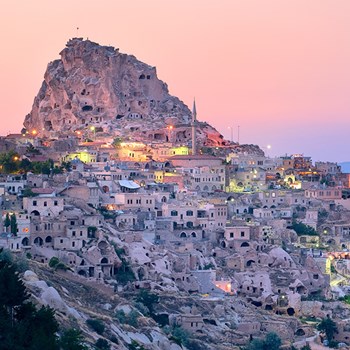A city known for its marvelous topography, the otherworldly beauty of Cappadocia’s volcanic landscape makes you feel like you’re on another planet! During your visit, go on a hot air balloon to get a bird’s-eye view of the city’s rocky hills, towering boulders, and narrow valleys is a must-try. However, Cappadocia in Turkey also has a plethora of activities beneath its surface, where you can check out its many underground cities and the architecture in the caverns. cappadocia turkey
Nearly 4 million tourists visited Türkiye’s famed, fairy-tale-like destination Cappadocia in the first 11 months of this year.
Cappadocia, a UNESCO world heritage site located in the central province of Nevsehir, became a popular destination worldwide in recent years thanks to its distinctive volcanic cones known as fairy chimneys, atmospheric underground cities, hot-air balloon trips, houses carved into rocks, and churches, chapels, and shelters used in the early years of the Christian faith.
Göreme National Park and the Rock Sites of Cappadocia cappadocia turkey
Located on the central Anatolia plateau within a volcanic landscape sculpted by erosion to form a succession of mountain ridges, valleys and pinnacles known as “fairy chimneys” or hoodoos, Göreme National Park and the Rock Sites of Cappadocia cover the region between the cities of Nevşehir, Ürgüp and Avanos, the sites of Karain, Karlık, Yeşilöz, Soğanlı and the subterranean cities of Kaymaklı and Derinkuyu. The area is bounded on the south and east by ranges of extinct volcanoes with Erciyes Dağ (3916 m) at one end and Hasan Dağ (3253 m) at the other. The density of its rock-hewn cells, churches, troglodyte villages and subterranean cities within the rock formations make it one of the world’s most striking and largest cave-dwelling complexes. Though interesting from a geological and ethnological point of view, the incomparable beauty of the decor of the Christian sanctuaries makes Cappadocia one of the leading examples of the post-iconoclastic Byzantine art period.
It is believed that the first signs of monastic activity in Cappadocia date back to the 4th century at which time small anchorite communities, acting on the teachings of Basileios the Great, Bishop of Kayseri, began inhabiting cells hewn in the rock. In later periods, in order to resist Arab invasions, they began banding together into troglodyte villages or subterranean towns such as Kaymakli or Derinkuyu which served as places of refuge.
Cappadocian monasticism was already well established in the iconoclastic period (725-842) as illustrated by the decoration of many sanctuaries which kept a strict minimum of symbols (most often sculpted or tempera painted crosses). However, after 842 many rupestral churches were dug in Cappadocia and richly decorated with brightly coloured figurative paintings. Those in the Göreme Valley include Tokalı Kilise and El Nazar Kilise (10th century), St. Barbara Kilise and Saklı Kilise (11th century) and Elmalı Kilise and Karanlık Kilise (end of the 12th – beginning of the 13th century).cappadocia turkey
Cappadocia’s museums and archaeological sites were visited by over 3.97 million people so far this year, said the Nevsehir Governorship.
Goreme Open Air Museum was visited by over 1 million people in 11 months.
Must see places:
Pigeon Valley

Pasabag

Uchisar Castle

Speaking to Anadolu Agency, tourist guide Elif Durdu said tourism in the region continues for 12 months, adding that the region draws attention from local and foreign tourists.
“Cappadocia is a place that has a different beauty in every season, both in terms of history and nature,” she said.
Ufukcan Atceken, another tourist guide, said that Cappadocia is an important tourism center, especially for the Western world. Atceken said hot air balloon tours, fairy chimneys and churches also play important roles in attracting visitors. cappadocia turkey



